Graduate alumni reunion and symposium highlights collaborative trajectories
Graduate alumni returned to campus on April 7 for a reunion and symposium celebrating the history, scholarship, and future of the Harvard John A. Paulson School of Engineering and Applied Sciences (SEAS).
The event, held as part of the annual Graduate School of Arts and Sciences (GSAS) alumni weekend, brought together more than 50 engineering and applied sciences graduates for a day of scientific lectures and networking opportunities.
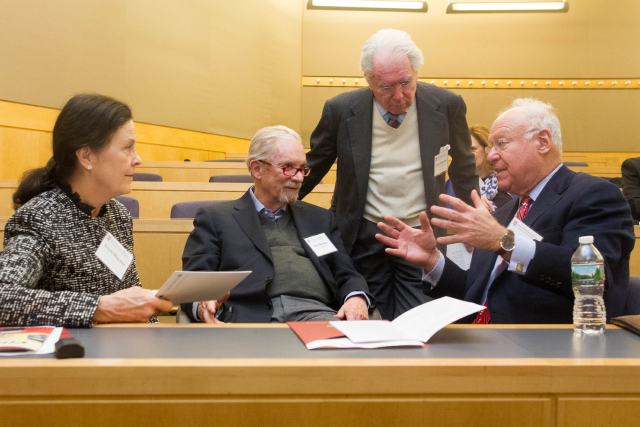
Graduate engineering and applied sciences alumni discuss the exciting changes coming to Harvard's campus during the April 7 reunion and symposium. (Photo by Bethany Versoy.)
Nearly 10 percent of the 34,000 GSAS alumni received engineering and applied sciences degrees. One goal of the event is to engage that audience in the latest advances and initiatives being spearheaded by SEAS, said Xiao-Li Meng, Ph.D. ’90, Dean of GSAS and Whipple V.N. Jones Professor Statistics, who opened the symposium with a welcome message.
“It is wonderful to see so many alumni back on campus, interacting with each other and speaking with faculty members,” he said. “I hope they walk away from the events today feeling excited about the future of SEAS and GSAS and inspired to continue supporting our programs and connecting with students.”
Francis J. Doyle III, John A. Paulson Dean and John A. & Elizabeth Armstrong Professor of Engineering and Applied Sciences, greeted attendees with an overview of Harvard’s 170-year tradition of engineering and applied sciences. Established in March 1847, the engineering program at Harvard is the oldest among Ivy League institutions. Engineering and applied sciences underwent numerous iterations over the intervening century and a half, including six name changes between 1918 and 1996, culminating in the official launch of SEAS as a school 10 years ago.
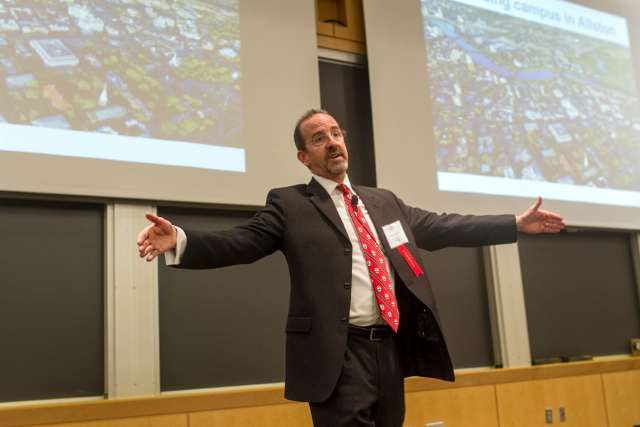
Dean Francis J. Doyle III shares highlights about the new Science and Engineering Complex with alumni. (Photo by Bethany Versoy.)
Drawing on that rich history, Doyle shared updates on the future of Harvard’s newest school, which will move into a state-of-the-art 500,000-square-foot Science and Engineering Complex in Boston’s Allston neighborhood when construction is completed in 2020. Proximity to Harvard Business School will foster increased entrepreneurial collaboration, Doyle said, while new graduate programs in data science and growing biosciences partnerships with the Harvard Medical School and the Harvard T.H. Chan School of Public Health highlight a synergistic trajectory.
“We really do serve as an integrator, a connector, an entity that is affecting the convergence between disciplines,” Doyle said. “Complex collaborations are the hallmark of what we do. We are knocking down boundaries between disciplines in a way that will enable incredible research in the coming decades.”
Attendees learned about some of that cutting-edge research during a series of concurrent presentations throughout the afternoon. Faculty members representing the breadth of scientific endeavors at SEAS spoke about advances in materials science, green energy storage, climate change, data science, and machine learning.
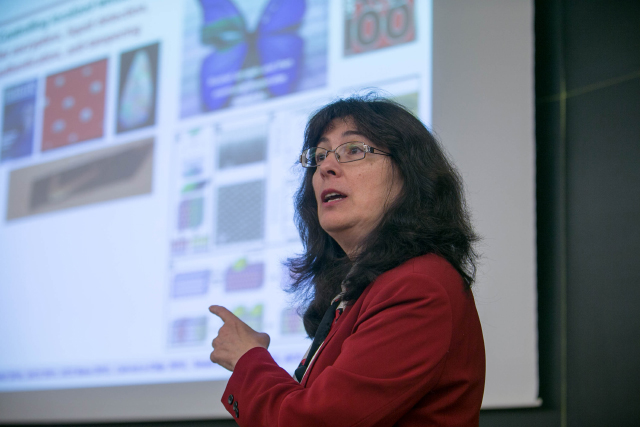
Joanna Aizenberg, Amy Smith Berylson Professor of Materials Science and Professor of Chemistry and Chemical Biology, discusses her bio-inspired research projects during the symposium. (Photo by Bethany Versoy.)
Linda Berzin Karma, A.B. ’80, S.M. ’80, applied mathematics, MBA ’82, was fascinated by the work of Joanna Aizenberg, Amy Smith Berylson Professor of Materials Science and Professor of Chemistry and Chemical Biology. Aizenberg discussed the development of bio-inspired synthetic materials, such as anti-fouling medical device coatings inspired by the carnivorous Nepenthes pitcher plant.
“Alumni days that allow us to have access to the latest and greatest research like this are not only intellectually stimulating, but also drive our commitment to the University,” Karma said.
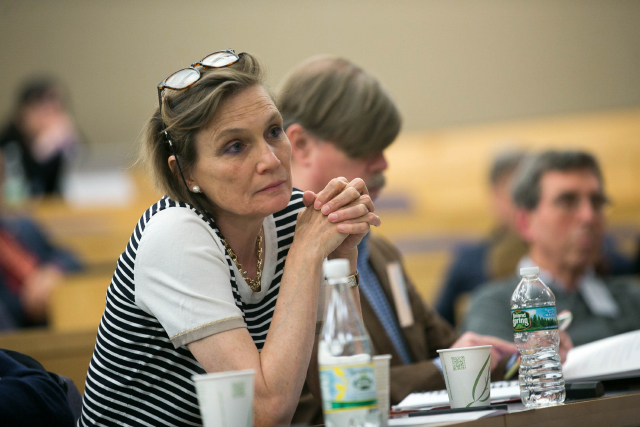
Alumna Linda Berzin Karma, A.B. ’80, S.M. ’80, applied mathematics, MBA ’82, listens during one of the faculty lectures. (Photo by Bethany Versoy.)
The afternoon concluded with a reception and poster session during which alumni explored a sampling of the innovative research projects being tackled by current SEAS graduate students. Sarah Johnson, S.M. ’78, engineering, was impressed by the fiber-reinforced soft actuator prototype presented by applied mathematics Ph.D. candidate Fionnuala Connolly.
“It is inspiring, not only to see a prototype that could potentially be used in a medical device, but to meet the person who made it,” she said. “It is fun to share in a student’s passion for research.”
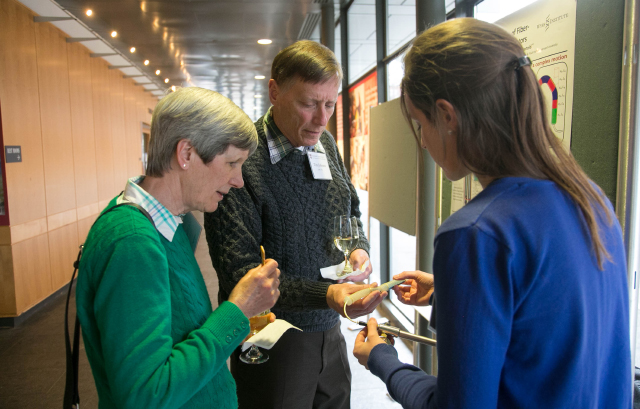
Sarah Johnson, S.M. ’78, engineering, and Timothy Johnson, MBA '76, speak with Ph.D. candidate Fionnuala Connolly about her fiber-reinforced soft actuator prototype. (Photo by Bethany Versory.)
For Chen C. Kao, A.M. ’65, Ph.D. ’69, applied sciences, a member of the reunion host committee, the event presented a unique opportunity to see how engineering and applied sciences at Harvard has grown and evolved since his days as a grad student.
“Science, engineering, and technology are advancing so rapidly, it is hard to know what is coming next. Having such fantastic engineering and applied sciences programs at Harvard is not just good for the University, it is good for society as a whole,” he said. “When I was a student, a half century ago, I would never have dreamed these collaborations were even possible. The trend of progress at SEAS is encouraging and exciting.”
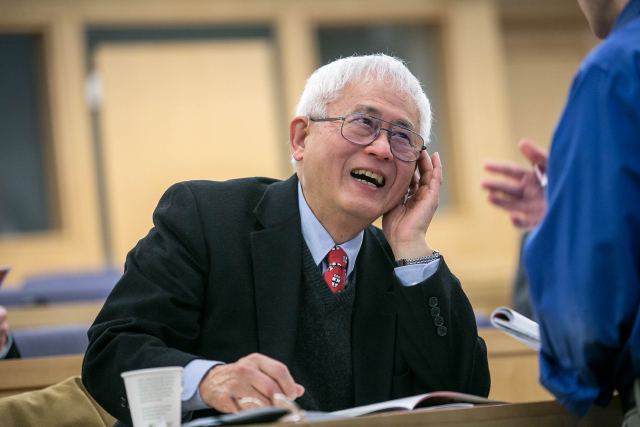
Alumnus Chen C. Kao, A.M. ’65, Ph.D. ’69, applied sciences, enjoys speaking with his fellow alumni. (Photo by Bethany Versoy.)